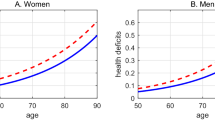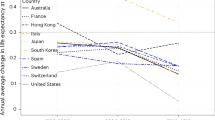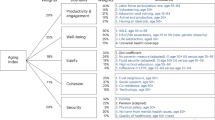Abstract
The future paths of population ageing result from specific combinations of declining fertility and increasing life expectancies in different parts of the world1. Here we measure the speed of population ageing by using conventional measures and new ones that take changes in longevity into account for the world as a whole and for 13 major regions. We report on future levels of indicators of ageing and the speed at which they change. We show how these depend on whether changes in life expectancy are taken into account. We also show that the speed of ageing is likely to increase over the coming decades and to decelerate in most regions by mid-century. All our measures indicate a continuous ageing of the world’s population throughout the century. The median age of the world’s population increases from 26.6 years in 2000 to 37.3 years in 2050 and then to 45.6 years in 2100, when it is not adjusted for longevity increase. When increases in life expectancy are taken into account2,3, the adjusted median age rises from 26.6 in 2000 to 31.1 in 2050 and only to 32.9 in 2100, slightly less than what it was in the China region in 2005. There are large differences in the regional patterns of ageing. In North America, the median age adjusted for life expectancy change falls throughout almost the entire century, whereas the conventional median age increases significantly. Our assessment of trends in ageing is based on new probabilistic population forecasts. The probability that growth in the world’s population will end during this century is 88%, somewhat higher than previously assessed4. After mid-century, lower rates of population growth are likely to coincide with slower rates of ageing.
This is a preview of subscription content, access via your institution
Access options
Subscription info for Japanese customers
We have a dedicated website for our Japanese customers. Please go to natureasia.com to subscribe to this journal.
Buy this article
- Purchase on SpringerLink
- Instant access to full article PDF
Prices may be subject to local taxes which are calculated during checkout




Similar content being viewed by others
References
United Nations. World Population Ageing 2007 (United Nations, New York, 2007)
Sanderson, W. & Scherbov, S. Average remaining lifetimes can increase as human populations age. Nature 435, 811–813 (2005)
Sanderson, W. & Scherbov, S. A new perspective on population aging. Demog. Res. 16, 27–58 (2006)
Lutz, W., Sanderson, W. & Scherbov, S. The end of world population growth. Nature 412, 543–545 (2001)
Harper, S. Ageing Societies: Myths, Challenges and Opportunities (Hodder Arnold, London, 2006)
Ryder, N. Notes on stationary populations. Popul. Index 41, 3–28 (1975)
Hersch, L. De la démographie actuelle à la démographie potentielle. Melange des Études Economiques Offertes à William Rappard (Georg, Geneva, 1944)
Panush, N. & Peritz, E. Potential demography. Eur. J. Popul. 12, 27–39 (1996)
Bongaarts, J. How long do we live? Popul. Dev. Rev. 32, 605–626 (2006)
Oeppen, J. & Vaupel, J. Broken limits to life expectancy. Science 296, 1029–1031 (2002)
Carnes, B. & Olshansky, S. J. A realistic view of aging, mortality and future longevity. Popul. Dev. Rev. 33, 367–381 (2007)
National Research Council. Beyond Six Billion: Forecasting the World’s Population (eds Bongaarts J. & Bulatao R., Panel on Population Projections, Committee on Population, Commission on Behavioral and Social Sciences and Education) (National Academy Press, Washington DC, 2000)
Lee, R. & Carter, L. Modeling and forecasting U.S. mortality. J. Am. Stat. Assoc. 87, 659–671 (1992)
Manton, K., Stallard, E. & Trolley, H. Limits to human life expectancy: evidence, prospects and implications. Popul. Dev. Rev. 17, 603–637 (1991)
Fries, J. Aging, natural death, and the compression or morbidity. N. Engl. J. Med. 303, 130–135 (1980)
Keilman, N. Ex-post errors in official population forecasts in industrialized countries. J. Off. Stat. 13, 245–277 (1997)
United Nations. World Population to 2300 (and associated database) (United Nations, New York, 2004)
Lutz, W., Scherbov, S., Cao, G. Y., Ren, Q. & Zheng, X. China’s uncertain demographic present and future. Vienna Yb. Pop. Res. 2007, 37–59 (2007)
Lutz, W., Sanderson, W. & Scherbov, S. in The End of World Population Growth in the 21st Century: New Challenges for Human Capital (eds Lutz, W., Sanderson, W. & Scherbov, S.) 17–84 (London, Earthscan, 2004)
Author information
Authors and Affiliations
Corresponding author
Supplementary information
Supplementary Information
The file contains Supplementary Tables 1-3 and Supplementary Figure 1. The Supplementary Information shows the results of IIASA’s new probabilistic population projections for 13 world regions and for the world as a whole (selected indicators for selected years). Information about more indicators and for single years of time can be found at http://www.iiasa.ac.at/Research/POP/proj07/index.html?sb=5 or directly from the corresponding author (PDF 188 kb)
Rights and permissions
About this article
Cite this article
Lutz, W., Sanderson, W. & Scherbov, S. The coming acceleration of global population ageing. Nature 451, 716–719 (2008). https://doi.org/10.1038/nature06516
Received:
Accepted:
Published:
Issue Date:
DOI: https://doi.org/10.1038/nature06516
This article is cited by
-
Which Comprehensive Geriatric Assessment (CGA) instruments are currently used in Germany: a survey
BMC Geriatrics (2024)
-
Associations between objectively measured overall and intensity-specific physical activity and phase angle in older adults
Scientific Reports (2024)
-
Eliminating senescent cells by white adipose tissue–targeted senotherapy alleviates age-related hepatic steatosis through decreasing lipolysis
GeroScience (2024)
-
Mortality burden and future projections of major risk factors for esophageal cancer in China from 1990 to 2019
General Thoracic and Cardiovascular Surgery (2024)
-
Population Aging in Atlantic Canada: A Regional Appraisal
Canadian Studies in Population (2024)



